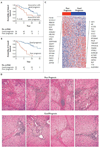Gene expression in fixed tissues and outcome in hepatocellular carcinoma
- PMID: 18923165
- PMCID: PMC2963075
- DOI: 10.1056/NEJMoa0804525
Gene expression in fixed tissues and outcome in hepatocellular carcinoma
Abstract
Background: It is a challenge to identify patients who, after undergoing potentially curative treatment for hepatocellular carcinoma, are at greatest risk for recurrence. Such high-risk patients could receive novel interventional measures. An obstacle to the development of genome-based predictors of outcome in patients with hepatocellular carcinoma has been the lack of a means to carry out genomewide expression profiling of fixed, as opposed to frozen, tissue.
Methods: We aimed to demonstrate the feasibility of gene-expression profiling of more than 6000 human genes in formalin-fixed, paraffin-embedded tissues. We applied the method to tissues from 307 patients with hepatocellular carcinoma, from four series of patients, to discover and validate a gene-expression signature associated with survival.
Results: The expression-profiling method for formalin-fixed, paraffin-embedded tissue was highly effective: samples from 90% of the patients yielded data of high quality, including samples that had been archived for more than 24 years. Gene-expression profiles of tumor tissue failed to yield a significant association with survival. In contrast, profiles of the surrounding nontumoral liver tissue were highly correlated with survival in a training set of tissue samples from 82 Japanese patients, and the signature was validated in tissues from an independent group of 225 patients from the United States and Europe (P=0.04).
Conclusions: We have demonstrated the feasibility of genomewide expression profiling of formalin-fixed, paraffin-embedded tissues and have shown that a reproducible gene-expression signature correlated with survival is present in liver tissue adjacent to the tumor in patients with hepatocellular carcinoma.
Copyright 2008 Massachusetts Medical Society.
Conflict of interest statement
No potential conflict of interest relevant to this article was reported.
Figures




Comment in
-
Recurrence of hepatocellular carcinoma.N Engl J Med. 2008 Nov 6;359(19):2045-7. doi: 10.1056/NEJMe0807581. Epub 2008 Oct 15. N Engl J Med. 2008. PMID: 18923166 No abstract available.
-
Transcriptome analysis of liver cancer: ready for the clinic?J Hepatol. 2009 May;50(5):1062-4. doi: 10.1016/j.jhep.2009.02.007. Epub 2009 Mar 9. J Hepatol. 2009. PMID: 19328580 Free PMC article.
References
-
- Llovet JM, Burroughs A, Bruix J. Hepatocellular carcinoma. Lancet. 2003;362:1907–1917. - PubMed
-
- Llovet JM, Bruix J. Novel advancements in the management of hepatocellular carcinoma in 2008. J Hepatol. 2008;48 Suppl 1:S20–S37. - PubMed
-
- Ikeda K, Arase Y, Saitoh S, et al. Interferon beta prevents recurrence of hepatocellular carcinoma after complete resection or ablation of the primary tumor: a prospective randomized study of hepatitis C virus-related liver cancer. Hepatology. 2000;32:228–232. - PubMed
-
- Muto Y, Moriwaki H, Ninomiya M, et al. Prevention of second primary tumors by an acyclic retinoid, polyprenoic acid, in patients with hepatocellular carcinoma. N Engl J Med. 1996;334:1561–1567. - PubMed
-
- Takayama T, Sekine T, Makuuchi M, et al. Adoptive immunotherapy to lower postsurgical recurrence rates of hepatocellular carcinoma: a randomised trial. Lancet. 2000;356:802–807. [Erratum, Lancet 2000;356:1690.] - PubMed
Publication types
MeSH terms
Grants and funding
LinkOut - more resources
Full Text Sources
Other Literature Sources
Medical
Molecular Biology Databases
